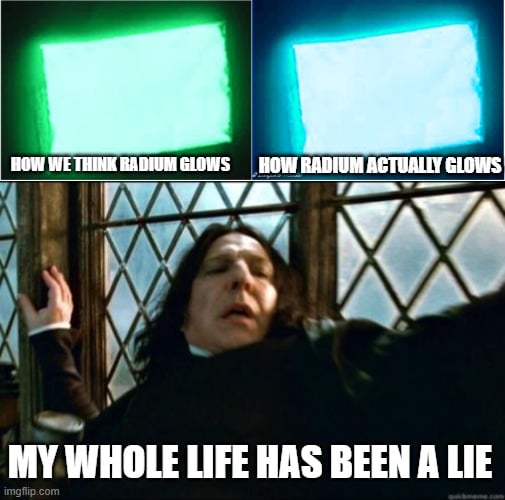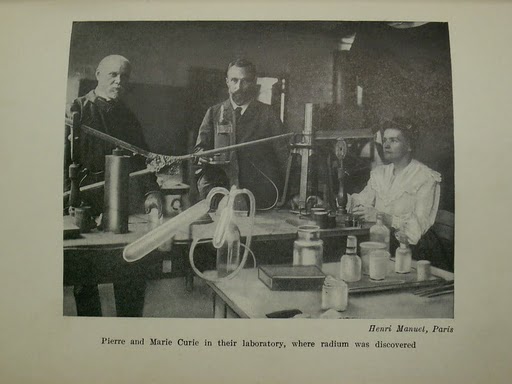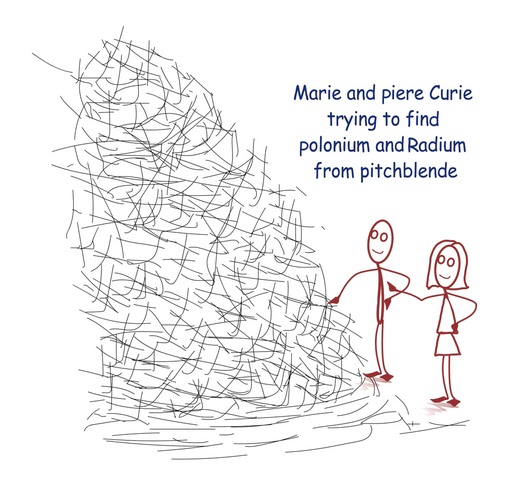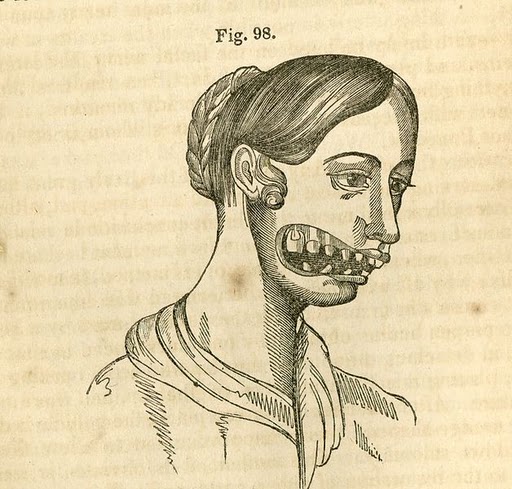The amazing discovery of Radium once captivated the world, but this substance is now handled very carefully due to its dangerous side effects caused by its radioactivity.
Radium is commonly associated with a faint green glow-in-the-dark color, but did you know that radium actually emits a light blue aura, not a green glow? Despite sounding unbelievable, it is the truth!
Since its discovery, the 88th element on the periodic table and its eerie radioactive rays have been involved in numerous unbelievable trends and events. Some of these have shaped how the world still deals with radioactive elements today!

Marie Curie And The Discovery Of Radium
Marie Curie’s scientific journey was well underway when French physicist Henri Becquerel began experimenting with his collection of luminescent salts (a collection he inherited from his father).
During a few days of cloudy skies in Paris, Becquerel discovered the unusual rays emitted by uranium salts. He later named these rays Uranic rays, as they could expose a photographic plate and create silhouettes.
Around the same time, Marie Skaldoswska Curie was working on magnetism with her husband, physicist Pierre Curie. She was searching for a topic for her doctoral thesis. The mysterious uranic rays caught Pierre’s attention, and he suggested that she study them for her work.
Marie then continued Becquerel’s research and started investigating the properties of Uranium rays. After closely studying the rays and their electrical effects, she concluded that uranium rays were an inherent property of the Uranium atom. The behavior of the rays depended solely on the atomic structure and the concentration of uranium atoms, unaffected by any external factors. This realization led to the term Radioactivity.

Her curiosity about pitchblende (the oxide ore of uranium) did not end with the discovery of radioactivity. She observed that the radioactivity exhibited by the ore was 4 times higher than that of uranium metal, indicating the presence of something more radioactive within the ore.
The Curies then undertook the monumental task of isolating the radioactive elements from an old abandoned shed that had previously been used as a dissection room by the school of medicine.
They boiled nearly 20 kgs of the ore in cast-iron cauldrons, dissolving it with solvents or acids as needed for separation. Through years of extensive trial and error, Marie and Pierre Curie discovered Polonium, named after Marie’s homeland, Poland, which was determined to be 60 times more radioactive than Uranium.
 Marie and Pierre Curie attempting to find polonium and radium from pitchblende
Marie and Pierre Curie attempting to find polonium and radium from pitchblende
However, the only radioactive element they successfully isolated was Radium (actually a salt of radium), which was approximately 400 times more radioactive than Uranium. This discovery marked the beginning of a new era in chemistry.
How Radium Became Incredibly Popular
In her autobiography, Marie Curie recalls the excitement of returning to the lab at night and seeing the glowing bottles and vials containing radium. The radiant glow and the substance’s ability to treat tumors without damaging the skin made radium a major fascination in the early 1900s.
Radium was seen as a magical elixir that could cure any ailment. This belief became popular when prominent scientists claimed that radioactivity could prevent insanity, slow down aging, and create a joyous life. A new form of chemotherapy, known as the “sipping cure,” involved patients drinking water infused with radium to treat cancer.
 Miracle drugs made of radium (Photo Credit: smallcurio/Wikimedia commons)
Miracle drugs made of radium (Photo Credit: smallcurio/Wikimedia commons)
Due to its rarity and high cost, the elite class hosted exclusive “sunshine dinners” where guests were served cocktails infused with radium, known as “liquid sunshine.” The guests claimed that consuming these cocktails filled them with vitality.
Ridiculous Radium Products
As radium became popular, it also led to the emergence of quackery in the commercial world. Companies started selling consumer products infused with radium, making absurd claims.
The market was flooded with products like cigarette holders with radium that supposedly neutralized the harmful effects of smoking. Radium-laced solar heating pads were marketed to recharge the blood and nervous system with a life-giving radioactive energy. Radium soaps, creams, and cosmetics promised radiant skin by taking the term “glowing skin” literally.
 Radium-laced cigarettes, cosmetics, and water (Photo Credit: snappygoat/Wikimedia commons)
Radium-laced cigarettes, cosmetics, and water (Photo Credit: snappygoat/Wikimedia commons)
Even the food industry joined in, offering radium-infused products such as chocolates, butter, bread, and beer. The most popular items were radium-enriched bottled water and ceramic jugs, claiming to provide radiant health.
To learn about more radium products from the past, click here.
The Radium Girls
Radium reached its peak of popularity during World War I. Tactical items like glow-in-the-dark compasses, ropes, flashlights, and watch dials were in high demand. These items were coated with a radium-based paint called “Undark”.
 Radium-painted dial (Photo Credit: Oliver Hion/Shutterstock & Public Domain)
Radium-painted dial (Photo Credit: Oliver Hion/Shutterstock & Public Domain)
Undark was a mixture of radium, zinc sulfide, and gum Arabic adhesive. When painted on surfaces, it emitted the characteristic green glow associated with radium. Although radium itself emits a blue glow, its interaction with zinc sulfide gives it a green hue!
In 1917, the US Radium Corporation hired young girls and women to paint watch dials with Undark. The painters were encouraged to shape the tip of the paintbrush with their lips to achieve precision. The media constantly promoted the positive effects of radium, leading some women to even paint their lips, teeth, and nails with the glowing paint.
Radium Poisoning
Unbeknownst to many, the women who were regularly consuming radium while wetting their brushes were unknowingly causing harm to themselves. The radium was slowly deteriorating their bodies from the inside. When radium is ingested, our body mistakenly replaces it for calcium, leading to necrosis in the bones and teeth.
 Artist’s representation of phossy jaw/ radium jaw (Photo Credit : Mutter/Wikimedia commons)
Artist’s representation of phossy jaw/ radium jaw (Photo Credit : Mutter/Wikimedia commons)
Over time, some of these women began experiencing symptoms such as decaying teeth, anemia, weak jawbones, and even death. Despite their complaints to their employer, no action was taken.
It wasn’t until the death of a millionaire named Eden Bryers, who consumed Radithor (water infused with radium) multiple times a day for its supposed health benefits, that the harmful effects of radium gained media attention.
For a long time, the Radium corporation denied the claims made by their employees. However, in the 1950s, they faced backlash from various parts of the country. Women who worked with radium-based paints were suffering from unexpected illnesses, and many had died from the side effects.
These events led to a significant legal battle between the US Radium Corporation and the Radium Girls. The girls sued the company for medical compensation and demanded stricter safety standards for the handling and use of radioactive materials. Their fight for justice has made the world a safer place in terms of radioactivity. The sound of a Geiger counter clicking over their lead-lined coffins serves as a reminder of how their actions saved countless lives.
Conclusion
Once a popular subject that inspired Broadway musicals like “Radium Dance,” radium is now associated with fear. The only modern use of radium is in the targeted treatment of prostate cancer cells, a procedure conducted under highly regulated conditions.
The reactions of people towards radium in the past may seem foolish to us in the 21st century. However, today’s society is equally susceptible to falling victim to trends based on anecdotal evidence. Therefore, let the story of radium serve as a cautionary tale, reminding us of the dangers of following fads without proper research or data to support them!
